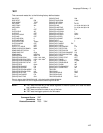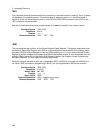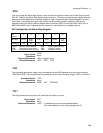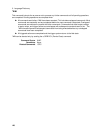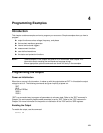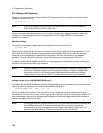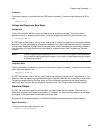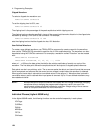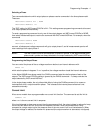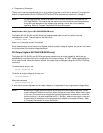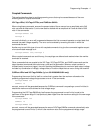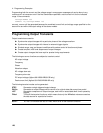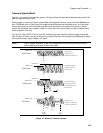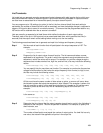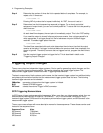
Programming Examples - 4
125
Selecting a Phase
Two commands determine which output phase or phases receive commands in the three-phase model.
These are:
INSTrument:COUPle ALL | NONE
INSTrument:NSELect <n>
The *RST setting for INSTrument:COUPle is ALL. This setting causes programming commands to be sent
to all output phases simultaneously.
To send a programming command to only one of the output phases, set INSTrument:COUPle to NONE,
then select the desired output to receive the command with INSTrument:NSELect. For example, when the
commands
INSTrument:COUPle NONE
INSTrument:NSELect 2
are sent, all subsequent voltage commands will go to output phase 2, and all measurement queries will
return readings from output phase 2.
NOTE: The INSTrument:COUPle command has no effect on queries. In the Agilent 6834B three-
phase model, queries are always directed to the output selected by INSTrument:NSELect.
Programming the Output Phase
You can control the phase of the ac voltage waveform relative to an internal reference with:
PHASe <n>
which sets the phase in degrees. If <n> is positive, the voltage waveform leads the internal reference.
In the Agilent 6834B three-phase model, the PHASe command sets the relative phase of each of the
outputs. The INSTrument:COUPle setting is ignored by the PHASe command -- it always controls the
output selected by INSTrument:NSELect.
In the single-phase models, the only discernible effect of using the PHASe command is to cause an
instantaneous shift in output waveform phase. This is because the internal phase reference is not
accessible externally.
Current Limit
All ac source models have a programmable rms current limit function. The command to set this limit is:
CURRent <n>
where <n> is the rms current limit in amperes.
If the load attempts to draw more current than the programmed limit, the output voltage is reduced to keep
the rms current within the limit. Since the rms detection involves a filter time constant that is long
compared to a single output cycle, the response time of the rms current limit is not instantaneous. When
the output voltage is reduced, its waveform is preserved (the output waveform is attenuated, not clipped).



